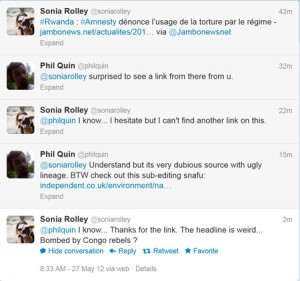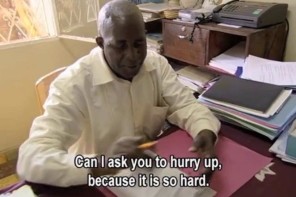A cautionary tale for journalists – don’t fall for PR and check your sources
This is how Rwandan PR reacts when a journalist tweets a link to a story about torture in Rwanda. On Sunday May 27th Radio France International journalist, Sonia Rolley, tweeted a link to a story in French about a submission by Amnesty International to the UN Committee against Torture. The Amnesty submission concerned the use of torture in Rwandan military detention facilities. Within 10 minutes of her tweet, she had a response from Phil Quin that attempted to discredit the source of the article. The link that Sonia Rolley tweeted was to a site in Belgium called Jambo News. This site is a news site run by young Rwandan students, too young to have what Phil Quin calls “an ugly lineage.” The suggestion of “ugly lineages” is how Rwanda, via its ever present and all pervasive PR machine, attempts to discredit criticism by suggesting overtly or otherwise, that the source is associated with or links to ‘genocidaires’. Notice how Phil Quin attempts to deftly redirect attention to a story about the DR Congo in the UK’s Independent newspaper. Phil Quin is an active user of Twitter when he is not advising the Rwandan Police Department how to manage their own PR. Of course, he fails to mention his PR work for the Rwandan Government on his Twitter profile. What is troubling but not unique, is the reaction of Sonia Rolley. She buys into the PR line immediately and admits to failing to find an alternative link to confirm the Jambo News article. That is both a sad indictment of contemporary journalism and a cautionary tale on the use of social media. It took me around 7 minutes to find the source directly and corroborate the truth of the Jambo News report.
I raise these issues because the accusations of “negationism” – genocide denying – or worse, whenever anyone raises any subject that may be critical of Rwanda, are a constant refrain. Sonia was just doing her job when she tweeted the original link and yet as soon as the tweet appeared Phil Quin attempts to discredit it. As a little research demonstrates, the article on Jambo News was reporting the facts of the Amnesty Report accurately and the attempts at discrediting the source are attempts to silence reporting that shouldn’t be allowed to pass. Sonia, a journalist who has produced many fine reports from Africa, has herself had the experience of being silenced by a repressive regime when she was thrown out of Chad in 2008. More importantly she was also evicted from Rwanda when RFI was indefinitely banned following a major clash between Rwanda and France over responsibility for the 1994 genocide. Thus allowing a source to be so easily discredited as “a dubious source with an ugly lineage” is questionable.
Rwanda, has of course, every right of reply to Amnesty’s allegations. It is worthwhile to note that the US State Department’s recently released country report for Rwanda, is equally critical of Rwanda’s human rights record. Although the State Department report takes note of attempts to improve media regulation in Rwanda and this is certainly a move in the right direction. However, as long as questions or debate are silenced by accusations of ‘genocide denial’ when that is clearly not the case, the criticisms of Rwanda’s human rights record and PR spin are only going to get louder.
Outline of the Amnesty International Report to the UN Committee Against Torture
In a May 2012 briefing to the UN Committee Against Torture, Amnesty International has denounced “torture and other ill-treatment” in military detention facilities. The report, which Amnesty claims is “not exhaustive”, documents “18 allegations of torture and other ill-treatment by Rwandan military intelligence and other security personnel.” The report only focuses on ill-treatment in military detention facilities and comments that the number of people at risk of torture or who may have been subjected to torture or other ill-treatment, is likely to be significantly higher than the number of cases documented.
“When I got to the point of dying, I told them to bring me a piece of paper [to sign], but they continued to torture me.”
The report documents the use of electric shocks, beatings, bags forced over victim’s heads to restrict breathing, starvation, and solitary confinement during which: “their hands were handcuffed behind their back and their legs were chained together. ” This is alongside secret detention and enforced disappearance, denial of access to legal representation, denial of medical treatment and confessions and evidence obtained through the use of torture. Many of the victims were young males between the ages of 15 and 40.
See also: Writing Rwanda: cognitive dissidents for more on Rwandan PR





This text іѕ invaluable. How can Ι find outt moге?